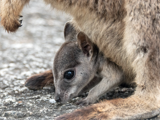If the animal is injured
-
Assess the Situation: Approach the turtle calmly and carefully to assess its condition. Keep in mind that injured turtles can be frightened and may try to bite or scratch, so approach from the side or behind where possible.
-
Ensure Safety: If the turtle is in a dangerous location (e.g., near a road or in shallow water), ensure your safety and then move the turtle to a safer area. Use gloves or a towel to handle the turtle to protect yourself and to avoid causing further injury.
-
Containment: If possible, gently lift the injured turtle and place it into a ventilated container such as a sturdy cardboard box or a plastic container with air holes. Line the container with a soft cloth or towel to provide comfort and prevent the turtle from sliding around during transport.
-
Keep Warm and Moist: Turtles are ectothermic (cold-blooded) and can become stressed if they get too cold. Keep the turtle in a quiet, dark place away from noise and sudden movements. Use a heating pad set on low or a warm water bottle wrapped in a towel to maintain a stable and warm environment for the turtle. Mist the inside of the container with water to keep the humidity levels up, as turtles can become dehydrated when injured.
-
Seek Professional Help: Contact a local wildlife rescue organisation, marine wildlife rehabilitation center, or your state's wildlife agency as soon as possible. These organizations have the expertise and resources to provide proper medical care and rehabilitation for injured turtles.
-
Do Not Offer Food or Water: Refrain from offering food or water to the injured turtle. It's important to leave this to trained wildlife carers who can assess its condition properly and provide appropriate care.
-
Transport Carefully: If you need to transport the turtle to a wildlife rescue facility, ensure the container is secure and well-ventilated. Avoid excessive handling or shaking during transport to minimize stress and further injury to the turtle.
-
Follow Advice: Follow any advice or instructions given by the wildlife rescue organization or rehabilitator. They may provide further guidance on caring for the turtle or transport instructions if you need to take it to them directly.
If the animal is dead
-
Handle with Care: Use gloves or a plastic bag to handle the turtle to minimize direct contact. Turtles can carry diseases, and some species may have sharp claws or beaks that could cause injury.
-
Document and Identify: If possible and safe to do so, take note of the location where the turtle was found and any visible characteristics that might help identify the species. This information can be helpful if you decide to report the finding to authorities.
-
Dispose Properly: Place the dead turtle in a sealed plastic bag and then dispose of it in your household waste bin. Do not bury it or leave it exposed, as this could attract scavengers or spread disease.
-
Report to Authorities (Optional): While it's not always necessary, you can report the finding to local authorities such as the local council, state wildlife agency, or a marine wildlife rescue organisation. They may be interested in monitoring local turtle populations or investigating potential threats to their health.
-
Personal Hygiene: After handling the turtle or disposing of it, wash your hands thoroughly with soap and water to reduce the risk of any potential contamination.
-
Observe for Other Wildlife: Keep an eye out for other sick or injured wildlife in the area. If you notice a pattern of deaths among wildlife, especially if it seems unusual or widespread, reporting it to authorities may be important for investigation and conservation efforts.

Be a Wildlife Hero
Make a difference today by supporting Kanyana Wildlife.
Join us in safeguarding Australia's precious wildlife through rescue, rehabilitation, and habitat protection.
Your support powers our mission and your generosity directly impacts the lives of injured, orphaned, and displaced animals in need. Together, we can make a lasting impact on wildlife conservation right here in Western Australia.
Whether you donate, volunteer, or adopt, you're making a difference.

